In this article, we will understand the Series and Parallel connections. The electrical devices are connected in the series and parallel as per the applications.
We will discuss the series and parallel circuits of the following electrical equipment.
a) Bulb
b) Batteries
c) Resistor
d) Capacitor
Series and Parallel Connection of Bulbs
Series connection of Bulbs
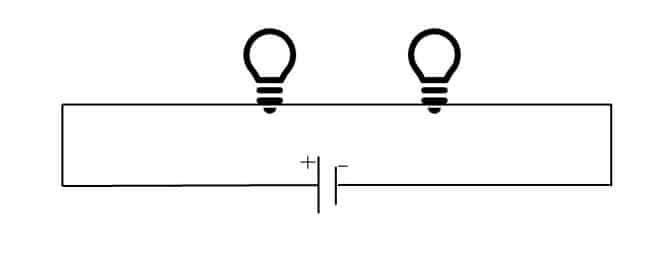
- Connect the positive terminal of the battery to one terminal of 1st bulb
- Then, Connect another terminal of 1st bulb to one terminal of 2nd bulb
- Connect another terminal of 2nd bulb to the negative terminal of the battery.
- We call this type of connection a series connection.
Parallel connection of Bulbs
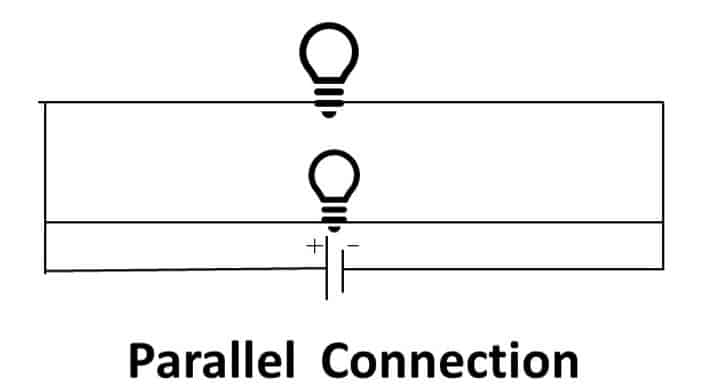
- Connect one terminal of all bulbs to the positive terminal of the battery.
- Connect another terminal of all bulbs to the negative terminal of the battery.
- This type of connection is called a parallel connection.
Let’s do this practically and note down the observations.
- In which scenario bulb glows brighter, series or parallel Connection?
- What will happen if any blub gets faulty in Series or Parallel Connection?
Hint: Our Home wiring is an example of a Parallel connection.
You have connected all three bulbs in series in the above experiment and observed the brightness of the bulbs. Remove one bulb and see the brightness again. Observe that brightness is increased.
Repeat the experiment and observe the following:
- With only one bulb connected to a battery bank:
– It glows with maximum brightness
– Potential difference in the circuit is maximum. - Connecting two bulbs in the circuit
– Both bulbs glow less bright
– Potential difference in the circuit is reduced. - Connecting three bulbs in series
– All bulbs glow very faintly
– Potential difference in the circuit is minimal.
- In a series circuit, If the circuit is broken at any point then the current in the circuit is zero. If one of the bulbs blew out, the other bulb will not glow because the flow of electrons is incomplete. I.e. the circuit is incomplete.
- In a parallel circuit, even if one of the bulbs blows out, the other bulb will still have electrons flowing through it, and it will continue to glow. Parallel circuits are the types of circuits that are found in house wiring. Obviously, when you turn off your Fan, it doesn’t turn off your Light. Connecting bulbs in parallel allow each to shine equally brightly.
Series and Parallel Connections of Batteries
Series connection of Batteries
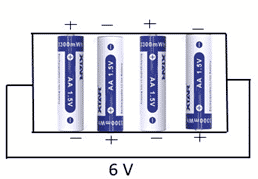
Batteries connected in series have a negative terminal of one cell connected to the positive terminal of another and vice versa as shown in the above figure. By connecting these cells in series the total voltage increases whereas the capacity of each battery remains the same.
Here, there are four cells of 1.5 V. connected in the series. Since cells are connected in series the total voltage is
V= V1+V2+V3+V4
= 1.5 V + 1.5 V + 1.5 V + 1.5 V
V= 6 V
Parallel Connection of Batteries
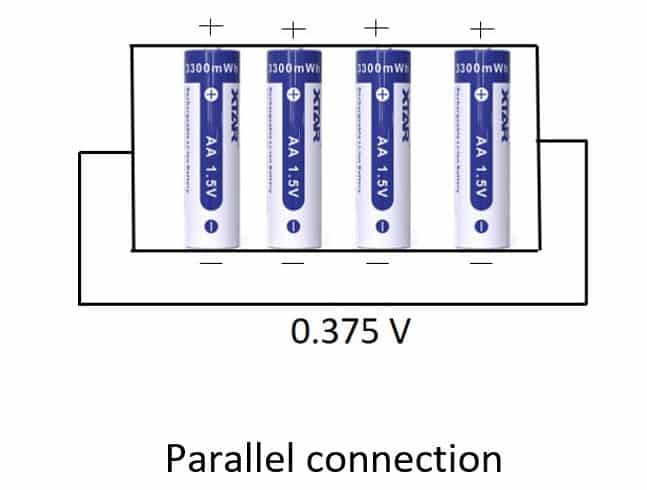
We connect all Positive terminals to each other at one end, and all negative terminals of batteries to each other at the other end. We call this type of battery connection a parallel connection.
The equivalent voltage of the batteries in the parallel is equal to the voltage of the battery that has maximum voltage. For example, if we connect, 2 volts, 4 volts & 5 volts battery in parallel the final voltage will be 5 volts. Therefore, the equal voltage & ampere-hours rating batteries are connected in parallel.
Series and Parallel Connection of Resistors
Individual resistors can be connected together in a series connection, a parallel connection, or combinations of both series and parallel, to produce more complex resistor networks whose equivalent resistance is the mathematical combination of the individual resistors connected together.
Resistors in series or complicated resistor networks can be replaced by one single equivalent resistor.
Resistors in Series


As the resistors are connected in the series, the same current passes through each resistor, and the total resistance, RT of the circuit is equal to the sum of all the individual resistors added together. That is
RT = R1 + R2 + R3 = 1kΩ + 2kΩ + 6kΩ = 9kΩ
Resistors in Parallel
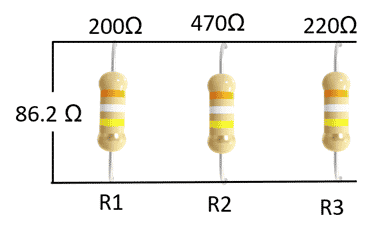
The equivalent resistance of the parallel connected resistors is

In the following example the resistors R1, R2 and R3 are all connected in Parallel combination,
Total Resistance in Parallel circuit is calculated as
1/RT = 1/R1+1/R2+1/R3
In above diagram, R1 = 200Ω, R2= 470 Ω, R3= 220 Ω
1/RT = 1/R1+1/R2+1/R3=
= 1/200 + 1/470 + 1/220
= 0.0050 + 0.0021 + 0.0045
1/RT = 0.0116
RT = 1/0.0116
RT= 86.2 Ω
Series and Parallel Connection of Capacitors
Capacitors in Series

When capacitors are connected one after another, this is called a Series Connection.
To calculate the total capacitance of capacitors connected in this way we can use the following formula:

Example: To calculate the total capacitance for these three capacitors in series.
C1= 10 F, C2= 10F, C3= 33F
1/CT= 1/10+1/10+1/33
= 0.1+0.1+0.03
= 0.23
CT = 1/0.23
CT= 4.35 Farad
Capacitors in Parallel
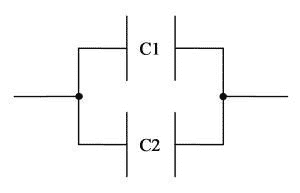
When capacitors are connected across each other (side by side) this is called a parallel connection. To calculate the total capacitance, Add the individual capacitances using the following formula:
C Total = C1 + C2 + C3 +……..+Cn
Example:
To calculate the total capacitance for these three capacitors in parallel.
C1= 10 F, C2= 10F, C3= 33F
CT = C1 + C2 + C3
= 10+10+33
CT = 53 F